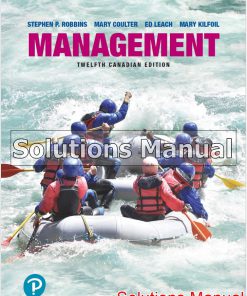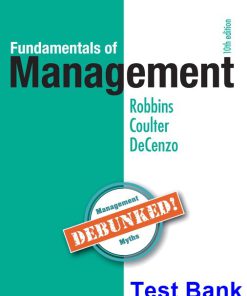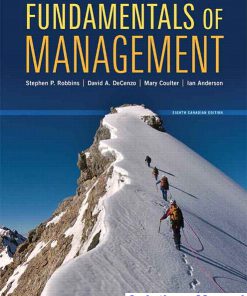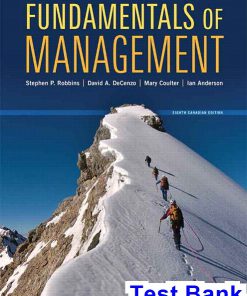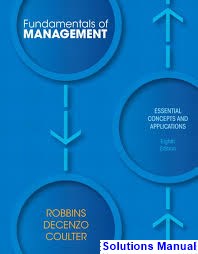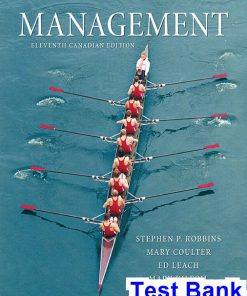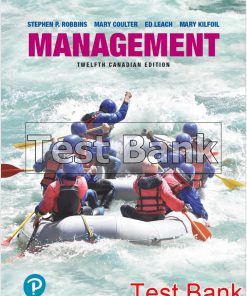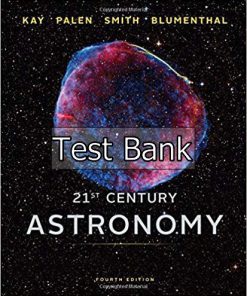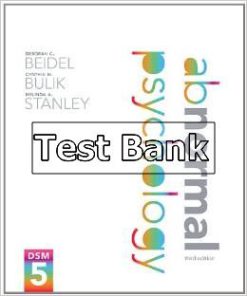Fundamentals of Management Seventh Canadian Edition Canadian 7th Edition Robbins Test Bank
$50.00 Original price was: $50.00.$26.50Current price is: $26.50.
Fundamentals of Management Seventh Canadian Edition Canadian 7th Edition Robbins Test Bank.
This is completed downloadable of Fundamentals of Management Seventh Canadian Edition Canadian 7th Edition Robbins Test Bank

Product Details:
- ISBN-10 : 0132606925
- ISBN-13 : 978-0132606929
- Author: Stephen P. Robbins (Author), David A. DeCenzo (Author), Mary A. Coulter (Author), Ian Anderson (Author)
This brief paperback text gives students more depth and breadth of practical tools to practice their management skills than any other textbook. This edition continues its fresh approach to management coverage through current and relevant examples, updated theory, and a new pedagogically sound design.
Table of Content:
- Chapter 1 Introduction to Management and Organizations
- Learning Objectives
- Why Study Management?
- What Is Management?
- Efficiency and Effectiveness
- Who Are Managers?
- The Organizational Setting
- What Three Characteristics do All Organizations Share?
- How Are Managers Different from Nonmanagerial Employees?
- What Titles Do Managers Have?
- Is the Manager’s Job Universal?
- Level in the Organization
- Profit Versus Not-For-Profit
- Size of Organization
- Management Concepts and National Borders
- What Do Managers Do?
- Four Functions Approach
- Planning
- Organizing
- Leading
- Controlling
- Management Roles Approach
- Functions versus Roles
- Skills and Competencies Approach
- What Factors Are Reshaping and Redefining Management?
- Why Are Customers Important to the Manager’s Job?
- Why Is Innovation Important to the Manager’s Job?
- Importance of Social Media to the Manager’s Job
- Importance of Sustainability to the Manager’s Job
- Chapter Summary
- Learning Objectives Checklist
- Discussion Questions
- Developing Management Skills
- Dilemma
- Becoming a Manager
- Becoming Politically Adept
- Skill Basics
- Diversity Matters
- Hey, You’re the Boss Now!
- Team Exercises
- 3BL: The Triple Bottom Line
- What are the Business Case Benefits of 3BL?
- Thinking Strategically About 3BL
- Be the Consultant
- Business Cases
- Shopify
- Discussion Questions
- Building a Better Boss
- Discussion Questions
- Who Needs a Boss?
- Discussion Questions
- Supplement 1A A Brief History of Management
- Early Management
- Classical Approaches
- Behavioural Approach
- Quantitative Approach
- Contemporary Approaches
- Contemporary Approaches
- Supplement 1B Small and Medium-Sized Enterprises and Organizations
- What Are Small and Medium-Sized Enterprises?
- Key Findings9, 10
- What Are Small and Medium-Sized Organizations?
- Key Findings16
- SMEs and SMOs in Canada: Key Characteristics
- Management in SMEs and SMOs
- Human Resources in SMEs and SMOs
- Financing in SMEs and SMOs
- Innovation in SMEs and SMOs
- Networks and Partnerships in SMEs and SMOs
- Supplement 1C Entrepreneurship1
- What Do Entrepreneurs Do?
- What Planning Do Entrepreneurs Need to Do?
- What’s in a Full Business Plan?
- Executive Summary
- Analysis of Opportunity
- Analysis of the Context
- Description of the Business
- Financial Data and Projections
- Supporting Documentation
- Components of a Good Business Plan
- What Issues Are Involved in Organizing an Entrepreneurial Venture?
- What Are the Legal Forms of Organization for Entrepreneurial Ventures?
- What Type of Organizational Structure Should Entrepreneurial Ventures Use?
- What Human Resource Management (HRM) Issues Do Entrepreneurs Face?
- What Issues Do Entrepreneurs Face in Leading an Entrepreneurial Venture?
- What Type of Personality Do Entrepreneurs Have?
- How Can Entrepreneurs Motivate Employees?
- How Can Entrepreneurs Be Leaders?
- What Controlling Issues Do Entrepreneurs Face?
- How Is Growth Managed?
- How Are Downturns Managed?
- What’s Involved with Exiting the Venture?
- Chapter 2 Environmental Constraints on Managers
- Learning Objectives
- The External Environment
- The Specific Environment
- The General Environment
- Political Conditions
- Economic Conditions
- Sociocultural Conditions
- Technological Conditions
- Environmental Conditions
- Legal Conditions
- Understanding the Global Environment
- PESTEL—Global Environment
- What Does It Mean to Be “Global”?
- What Are the Different Types of Global Organizations?
- How Organizations Go Global
- Importing and Exporting
- Licensing and Franchising
- Strategic Alliance
- Foreign Subsidiary
- Which Is More Important to a Manager: National Culture or Organizational Culture?
- Organizational Culture
- Strong Versus Weak Cultures
- Developing an Organization’s Culture
- How Culture Affects Managers
- How the Environment Affects Managers
- Assessing Environmental Uncertainty
- Chapter Summary
- Learning Objectives Checklist
- Discussion Questions
- Developing Management Skills
- Dilemma
- Becoming a Manager
- Hey, You’re the Boss Now!
- Questions
- 3BL: The Triple Bottom Line
- Can Technology Improve the Way Managers Manage?
- Thinking Strategically About 3BL
- Team Exercises
- Be the Consultant: Understanding Culture
- Assessing Employees’ Global Aptitudes
- Business Cases
- Joe Fresh
- Discussion Questions
- Not Sold Out
- Discussion Questions
- Miovision Technologies Inc. (Internet of Things)
- Discussion Questions
- Chapter 3 Decision Making
- Learning Objectives
- The Decision-Making Process
- What Defines a Decision Problem?
- Step 1: Identify a Problem
- What Is Relevant in the Decision-Making Process?
- Step 2: Identify Decision Criteria
- How Does the Decision Maker Weigh the Criteria and Analyze Alternatives?
- Step 3: Allocate Weights to Criteria
- Step 4: Develop Alternatives
- Step 5: Analyze Alternatives
- What Determines the Best Choice?
- Step 6: Select an Alternative
- Step 7: Implement the Alternative
- Step 8: Evaluate Decision Effectiveness
- Factors Affecting Decision Making
- What Are the Three Approaches Managers Use to Make Decisions?
- 1 Rational Model
- 2 Bounded Rationality
- 3 Intuition and Managerial Decision Making
- Types of Problems and Decisions
- How do Problems Differ?
- Procedures
- Rules
- Policies
- How do Nonprogrammed Decisions Differ from Programmed Decisions?
- Decision-Making Conditions
- Certainty
- Risk
- Uncertainty
- Group Decision Making
- Individual Versus Group Decision Making
- Decision-Making Biases and Errors
- Contemporary Issues in Managerial Decision Making
- How Does National Culture Affect Managers’ Decision Making?
- Why Are Creativity and Design Thinking Important in Decision Making?
- Understanding Creativity
- Understanding Design Thinking
- How Is Big Data Changing the Way Managers Make Decisions?
- Quantitative Decision-Making AIDS
- Ethics, Corporate Social Responsibility, and Decision Making
- Four Views of Ethics
- Improving Ethical Behaviour
- Codes of Ethics and Decision Rules
- Corporate Social Responsibility
- Corporate Social Responsibility and Economic Performance
- Chapter Summary
- Learning Objectives Checklist
- Discussion Questions
- Developing Management Skills
- Dilemma
- Becoming a Manager
- Diversity Matters: The Value of Diversity in Decision Making81
- Team Exercises
- 3BL: The Triple Bottom Line
- Thinking Strategically About 3BL
- Individual Versus Group Decisions
- The Story
- Statements About the Story
- Business Cases
- The Business of Blue Jays Baseball
- Questions
- Coca-Cola and the Science of OJ
- Questions
- Credit Valley Hospital
- Questions
- Chapter 4 Planning and Strategic Management
- Learning Objectives
- What Is Planning and Why Do Managers Need to Plan?
- Planning Defined
- Why Do Managers Plan?
- Planning and Performance
- Criticisms of Planning
- How Do Managers Set Goals and Develop Plans?
- What Types of Goals Do Organizations Have, and How Do They Set Those Goals?
- Characteristics of Well-Designed Goals
- Steps in Goal Setting
- What Types of Plans Do Managers Use and How Do They Develop Those Plans?
- Types of Plans
- Breadth
- Time Frame
- Specificity
- Developing Plans
- Planning Tools and Techniques
- Forecasting
- Contingency Planning
- Scenario Planning
- Benchmarking
- Process Planning
- Organizational Strategy: Choosing a Niche
- Why Is Strategic Management Important?
- The Strategic Management Process
- Step 1: Identify the Organization’s Current Vision, Mission, Goals, and Strategies
- Step 2: Do an Internal Analysis
- Step 3: Do an External Analysis
- Pestel Analysis
- Step 4: Formulate Strategies
- Step 5: Implement Strategies
- Step 6: Evaluate Results
- What Strategies Do Managers Use?
- 1 Corporate Strategy
- 3 main corporate strategies
- 2 Competitive Strategy
- Important Role of Competitive Advantage
- Types of Competitive Strategies
- 3 Functional Strategy
- Social Media as a Strategic Weapon
- Big Data as a Strategic Weapon
- Competitive Strategies
- Chapter Summary
- Learning Objectives Checklist
- Discussion Questions
- Developing Management Skills
- Dilemma
- Becoming a Manager
- Developing Your Interpersonal Skills: Goal Setting for Your Professor
- About the Skill
- Practising the Skill
- Team Exercises
- 3BL: The Triple Bottom Line
- Ethical Competitive Intelligence
- Thinking Critically about Ethical Competitive Intelligence
- Your College or University’s Vision, Mission, and Strategies
- Hey, You’re the Boss Now!
- Business Cases
- SilverBirch Hotels & Resorts
- Prince Edward County
- Questions
- Fast Fashion
- Questions
- Chapter 5 Organizational Structure and Design
- Learning Objectives
- Key Elements in Organizational Structure
- Work Specialization
- Departmentalization
- Chain of Command
- Line and Staff Authority
- How do Authority and Power Differ?
- Span of Control
- Today’s View
- Centralization and Decentralization
- Today’s View
- Formalization
- Today’s View
- What Contingency Variables Affect Structural Choice?
- Mechanistic or Organic17
- Organic organization
- The “If”: Contingency Variables
- 1 Strategy—Structure
- 2 Size—Structure
- 3 Technology—Structure
- 4 Environment—Structure
- Common Organizational Designs
- Traditional Organizational Designs
- Simple Structure
- Functional Structure
- Divisional Structure
- Contemporary Organizational Designs
- Team Structure
- Matrix and Project Structures
- Boundaryless Organizations
- Virtual Organizations
- Network Organizations
- Contemporary Organizational Design Challenges
- Designing Office Space
- Keeping Employees Connected
- Building a Learning Organization
- Integrating Sustainability into the Organizational Structure
- 3BL: The Triple Bottom Line
- Thinking Strategically About 3BL
- Managing Global Structural Issues
- Designing Efficient and Effective Flexible Work Arrangements
- What’s Involved in Telecommuting?
- How Can Organizations Use Compressed Workweeks, Flextime, and Job Sharing?
- What is a Contingent Workforce?
- Chapter Summary
- Learning Objectives Checklist
- Discussion Questions
- Developing Management Skills
- Dilemma
- Becoming a Manager
- Diversity Matters
- Team Exercises
- Be the Consultant: The Nova Scotia Association of Social Workers
- Business Cases
- Pfizer: A New Kind of Structure
- Questions
- Levitt-Safety Limited
- Questions
- You Work Where?
- Discussion Questions
- Chapter 6 Human Resource Management
- Learning Objectives
- The Human Resource Management Process
- Environmental Factors Affecting HRM
- Organizational Culture
- Economic Conditions
- Labour-Market Issues
- Government Legislation
- Technology
- Planning Human Resource Needs
- (1) How Does an Organization Do a Current HR Assessment?
- (2) How Are Future Employee Needs Determined?
- (3) Balancing Supply and Demand
- Recruiting
- Where Does a Manager Recruit Applicants?
- Selection
- What is Reliability?
- What is Validity?
- How Effective Are Tests and Interviews as Selection Devices?
- How Can You “Close the Deal”?
- Orientation and Training
- How Are New Hires Introduced to the Organization?
- Training
- How Are Employees Trained?
- How can Managers Ensure that Training is Working?
- Total Rewards: Five Key Components
- 1 Strategic Compensation
- 2 Benefits
- 3 Work–Life Balance
- 4 Performance and Recognition
- Performance Management System
- Performance Appraisal Methods
- 5 Career Development
- Contemporary Human Resource Management Issues
- How Can Workforce Diversity Be Managed?
- What Is Sexual Harassment?
- Bullying
- Occupational Health and Safety
- Employee Wellness
- Chapter Summary
- Learning Objectives Checklist
- Discussion Questions
- Developing Management Skills
- Dilemma
- Becoming a Manager
- Developing Your Diagnostic and Analytical Skills: Dealing with a Difficult Person
- Developing Your Interpersonal Skills: Providing Good Feedback
- Providing Good Feedback
- Skill Basics
- 3BL: The Triple Bottom Line
- People
- Profit
- Planet
- Thinking strategically about 3BL
- Team Exercises
- Networking: The 30-Second Commercial
- Option A
- Option B
- Be the Consultant
- Business Cases
- Wellington West
- Dealing with Romance in the Workplace
- Questions
- Spotting Talent
- Discussion Questions
- Chapter 7 Managing Innovation and Change
- Learning Objectives
- What is Change and How Do Managers Deal with it?
- Why Do Organizations Need to Change?
- What External Forces Create a Need to Change?
- What Internal Forces Create a Need to Change?
- Who Initiates Organizational Change?
- How Does Organizational Change Happen?
- 1. What is the “Calm Waters” Metaphor?
- 2. What is the “White-Water Rapids” Metaphor?
- Does Every Manager Face a World of Constant and Chaotic Change?
- How Do Organizations Implement Planned Changes?
- How Do Managers Manage Resistance to Change?
- Why Do People Resist Organizational Change?
- What Are Some Techniques for Reducing Resistance to Organizational Change?
- Common Approaches to Organizational Change
- Action Research
- Appreciative Inquiry
- Making Change Happen Successfully
- Communicating Effectively When Undergoing Change
- What Reaction Do Employees Have to Organizational Change?
- What Causes Stress? Stressors
- Job-Related Factors
- Personal Factors
- How Can Stress Be Reduced?
- How Can Managers Encourage Innovation in an Organization?
- How Are Creativity and Innovation Related?
- What’s Involved in Innovation?
- How Can a Manager Foster Innovation?
- How do Structural Variables Affect Innovation?
- How Does an Organization’s Culture Affect Innovation?
- What Human Resource Variables Affect Innovation?
- How Does Design Thinking Influence Innovation?
- Chapter Summary
- Learning Objectives Checklist
- Discussion Questions
- Developing Management Skills
- Dilemma
- Developing Your Interpersonal Skills: Managing Resistance to Change
- About the Skill
- Steps in Developing the Skill
- Practising the Skill
- Developing Your Interpersonal Skills: Stress Management
- About the Skill
- Steps in Developing the Skill
- Diversity Matters
- Team Exercises
- 3BL: The Triple Bottom Line
- How Can Companies Make the Change Toward Sustainability?
- Thinking Practically About 3BL
- Be the Consultant: The Celestial Aerospace Company
- Objectives
- The Situation
- Procedure
- Business Cases
- Prairie General Hospital
- Discussion Questions
- The Next Big Thing
- Discussion Questions
- Innovation in Wastewater
- Discussion Questions
- Chapter 8 Understanding Groups and Teams
- Learning Objectives
- What Is a Group and What Stages of Development Do Groups Go Through?
- What Is a Group?
- Are Work Groups and Work Teams the Same?
- Stages of Group Development
- Key Aspects of Group Behaviour
- 1 Roles
- 2a Norms
- 2b Conformity
- 3 Status Systems
- 4 Group Size
- Drawbacks of large groups
- 5 Group Cohesiveness
- Turning Groups into Effective Teams
- Characteristics of Effective Teams
- What Contextual Factors Lead to Team Effectiveness?
- What Team Composition Factors Lead to Effectiveness?
- How Does Work Design Affect Team Effectiveness?
- What Team Processes Are Related to Team Effectiveness?
- How Can a Manager Shape Team Behaviour?
- Selection
- Training
- Rewards
- Current Challenges in Managing Teams
- What’s Involved with Managing Global Teams?
- How Do Team Composition Factors Affect Managing a Global Team?
- How Does Team Structure Affect Managing a Global Team?
- How Do Team Processes Affect Managing a Global Team?
- Beware! Teams Are Not Always the Answer
- Chapter Summary
- Learning Objectives Checklist
- Discussion Questions
- Developing Management Skills
- Dilemma
- Developing Your Interpersonal Skills: Creating Effective Teams
- About the Skill
- Steps in Developing the Skill
- Practising the Skill
- Team Exercises
- 3BL: The Triple Bottom Line
- Thinking Strategically About 3BL
- Be the Consultant: Chairing Effective Meetings
- Business Cases
- Whole Foods Canada
- Discussion Questions
- Toyota Canada
- Discussion Questions
- The Go Game—Team Building
- Discussion Questions
- Chapter 9 Motivating and Rewarding Employees
- Learning Objectives
- Motivation
- Early Theories of Motivation (1950s and 1960s)
- Maslow’s Hierarchy of Needs Theory
- How is Maslow’s hierarchy used to motivate employees?
- McGregor’s Theory X and Theory Y
- Herzberg’s Two-Factor Theory
- Research focus
- Motivating Employees
- McClelland’s Three-Needs Theory
- Contemporary Theories of Motivation
- Goal-Setting Theory
- How Does Job Design Influence Motivation?
- Four-Drive Theory
- Equity Theory
- Expectancy Theory
- Integrating Contemporary Theories of Motivation
- Current Issues in Motivation
- Motivating Employees When the Economy Stinks
- Motivating Unique Groups of Workers
- (1) Motivating a Diverse Workforce
- Motivating Professional and Technical Employees
- Motivating Contingent Workers
- Designing Effective Rewards Programs That Motivate Employees
- The Role of Money
- Open-Book Management
- Employee Recognition Programs
- Pay-For-Performance Programs
- Improving Work–Life Balance
- Flexible Work Schedules
- Job Sharing
- Telework
- Suggestions for Motivating Employees
- Chapter Summary
- Learning Objectives Checklist
- Discussion Questions
- Developing Management Skills
- Dilemma
- Becoming a Manager
- Developing Your Diagnostic and Analytical Skills: Twenty-First-Century Factory Town
- Questions
- Team Exercises
- 3BL: The Triple Bottom Line
- Thinking Strategically About 3BL
- What Rewards Motivate You?
- How Can You Motivate Others?
- Be the Consultant
- Business Cases
- DevFacto Technologies
- Discussion Questions
- Ubisoft Entertainment SA
- Discussion Questions
- One for the Money…
- Discussion Questions
- Chapter 10 Leadership
- Learning Objectives
- Who Are Leaders and What Is Leadership?
- What Do Early Leadership Theories Tell Us About Leadership?
- THE LEADER What Traits Do Leaders Have?
- What do You Know About Leadership?
- What Now?
- THE BEHAVIOURS What Behaviours Do Leaders Exhibit?
- What Now?
- Contingency Theories of Leadership
- What Was the First Comprehensive Contingency Model?
- How Do Followers’ Willingness and Ability Influence Leaders?
- How Participative Should a Leader Be?
- How Do Leaders Help Followers?
- Contemporary Views of Leadership
- How Do Leaders Interact with Followers?
- How Do Transactional Leaders Differ from Transformational Leaders?
- How Do Charismatic Leadership and Visionary Leadership Differ?
- Current Issues in Leadership
- Why Do Leaders Need to Empower Employees?
- Team Leadership
- Managing Power
- Providing Ethical Leadership
- Does National Culture Affect Leadership?
- How Does Emotional Intelligence Affect Leadership?
- Why Is Trust the Essence of Leadership?
- Why Is it Important That Followers Trust Their Leaders?
- A Final Thought Regarding Leadership
- Chapter Summary
- Learning Objectives Checklist
- Discussion Questions
- Developing Management Skills
- Being a Good Leader
- Skill Basics
- Increasing Your Power
- Skill Basics
- Practising the Skill
- Developing Your Diagnostic and Analytical Skills: Radical Leadership
- Questions
- Team Exercises
- 3BL: The Triple Bottom Line
- Thinking Strategically About 3BL
- The Pre–Post Leadership Assessment
- Objective
- Procedure
- Be the Consultant: Hiring Ethical Leaders
- Business Cases
- Developing Gen Y Leaders
- Discussion Questions
- Serving up Leaders
- Discussion Questions
- Rowe
- Discussion Questions
- Chapter 11 Managing Communication and Information
- Learning Objectives
- Effective Communication
- How Does the Communication Process Work?
- Are Written Communications More Effective than Verbal Ones?
- Is the Grapevine an Effective Way to Communicate?
- How Do Nonverbal Cues Affect Communication?
- What Barriers Keep Communication from Being Effective?
- How Does Filtering Affect Communication?
- How Does Selective Perception Affect Communication?
- How Does Information Overload Affect Communication?
- How Do Emotions Affect Communication?
- How Does Language Affect Communication?
- How Does Gender Affect Communication?
- How Does National Culture Affect Communication?
- How Can Managers Overcome Communication Barriers?
- Why Use Feedback?
- Why Should Simplified Language be Used?
- Why Must we Listen Actively?
- Why Must we Constrain Emotions?
- Why the Emphasis on Nonverbal Cues?
- Technology and Managerial Communication
- Networked Communication
- Networked Communication Applications
- Instant Messaging
- Wikis and Blogs
- Social Networking Websites
- Other networked communication applications
- Wireless Communication
- Wireless Communication Applications
- How Information Technology Affects Organizations
- Social Media
- How Businesses can use Social Media
- Navigating the Workplace Communication Protocols in a Technology Age
- What Communication Issues Do Managers Face Today?
- How Do We Manage Communication in an Internet World?
- Legal and Security Issues
- Personal Interaction
- How Does Knowledge Management Affect Communication?
- What’s Involved with Managing the Organization’s Knowledge Resources?
- What Role Does Communication Play in Customer Service?
- How Can We Get Employee Input and Why Should We?
- Why Should Managers Be Concerned with Communicating Ethically?
- Chapter Summary
- Learning Objectives Checklist
- Discussion Questions
- Developing Management Skills
- Team Exercises
- Be the Consultant
- Writing Better E-mails
- Procedure
- Business Cases
- Social Benefit or Social Disaster?
- Discussion Questions
- Banning E-mail. Banning Voice Mail
- Discussion Questions
- Delivering Bad News
- Principles to Remember
- Discussion Questions
- Chapter 12 Foundations of Control
- Learning Objectives
- What Is Control?
- Why Is Control Important?
- Performance Standards
- The Control Process
- What Is Measuring?
- How do Managers Measure?
- What We Measure
- How Do Managers Compare Actual Performance to Planned Goals?
- Benchmarking of Best Practices
- What Managerial Action Can Be Taken?
- How do you Correct Actual Performance?
- How do you Revise the Standard?
- What Should Managers Control?
- When to Introduce Control
- What is Feedforward Control?
- When is Concurrent Control Used?
- Why is Feedback Control so Popular?
- Keeping Track of an Organization’s Finances
- Keeping Track of an Organization’s Information
- Keeping Track of Employee Performance
- Keeping Track Using a Balanced Scorecard Approach
- Contemporary Issues in Control
- Corporate Governance
- The Role of Boards of Directors
- Cross-Cultural Differences
- Workplace Concerns
- Workplace Privacy
- Employee Theft
- What can Managers do About Workplace Violence?
- Chapter Summary
- Learning Objectives Checklist
- Discussion Questions
- Developing Management Skills
- Dilemma
- Practising the Skill
- Applying Feedforward, Concurrent, and Feedback Controls
- Team Exercises
- 3BL: The Triple Bottom Line
- Thinking Strategically About 3BL
- Be the Consultant: Financing a New Business Venture
- Business Cases
- Top Secret
- Discussion Questions
- Too Relaxed
- Discussion Questions
- Balanced Scorecard—Your Local Credit Union
- Discussion Questions
- Chapter 13 Operations Management
- Learning Objectives
- Why Is Operations Management Important to Organizations?
- What Is Operations Management?
- How Do Service and Manufacturing Firms Differ?
- How Do Businesses Improve Productivity?
- What Is Value Chain Management and Why Is It Important?
- 1 What Is Value Chain Management?
- Goals of Value Chain Management
- 2 How Does Value Chain Management Benefit Businesses?
- How Is Value Chain Management Done?
- Supply Chain Management
- What Are the Requirements for Successful Value Chain Management?
- What Are the Obstacles to Value Chain Management?
- Organizational Barriers
- Cultural Attitudes
- Required Capabilities
- People
- What Contemporary Issues Do Managers Face in Managing Operations?
- What Role Does Technology Play in Operations Management?
- How Do Managers Control Quality?
- How is Quality Achieved?
- What Quality Goals Might Organizations Pursue?
- How Are Projects Managed?
- How do you use a Gantt Chart?
- What is a Pert Network Analysis?
- How Does Pert Operate?
- How Does Lean Manufacturing Work?
- How to Decide About Outsourcing
- Chapter Summary
- Learning Objectives Checklist
- Discussion Questions
- Developing Management Skills
- Being a Good Conflict Manager
- Practising the Skill
- What Is My Negotiation Style?
- Analysis and Interpretation
- Practising the Skill
- Team Exercises
- Be the Consultant
- Business Cases
- Tragedy in Fashion
- Discussion Questions
- Cow-Milking Robots
- Discussion Questions
- Dreamliner Nightmare
- Discussion Questions
- Glossary
- Your Essential Management Reading List
- Chapter 1: Introduction to Management and Organizations
- Chapter 2: Environmental Constraints on Managers
- Chapter 3: Decision Making
- Chapter 4: Planning and Strategic Management
- Chapter 5: Organizational Structure and Design
- Chapter 6: Human Resource Management
- Chapter 7: Managing Innovation and Change
- Chapter 8: Understanding Groups and Teams
- Chapter 9: Motivating and Rewarding Employees
- Chapter 10: Leadership
- Chapter 11: Managing Communication and Information
- Chapter 12: Foundations of Control
- Chapter 13: Operations Management
- Endnotes
- Name/Organization Index
- A
- B
- C
- D
- E
- F
- G
- H
- I
- J
- K
- L
- M
- N
- O
- P
- Q
- R
- S
- T
- U
- V
- W
- X
- Y
- Z
- Subject Index
- A
- B
- C
- D
- E
- F
- G
- H
- I
- J
- K
- L
- M
- N
- O
- P
- Q
- R
- S
- T
- U
- V
- W
- Z
- List of Canadian Companies, by Province
- Alberta
- British Columbia
- Manitoba
- New Brunswick
- Nova Scotia
- Ontario
- Prince Edward Island
- Quebec
- Saskatchewan
- List of International Companies, by Country
- Australia
- Brazil
- China
- Denmark
- Finland
- France
- Germany
- Great Britain
- Hong Kong
- India
- Ireland
- Italy
- Japan
- Netherlands
- South Africa
- Spain
- Sweden
- Switzerland
- United Arab Emirates
- United States
People Also Search:
fundamentals of management seventh canadian edition canadian robbins
fundamentals of management seventh canadian edition canadian 7th edition robbins
fundamentals of management seventh canadian edition canadian
fundamentals of management seventh canadian edition canadian 7th edition
fundamentals of management seventh canadian edition canadian 7th edition testbank download pdf
fundamentals of management seventh canadian edition canadian 7th edition download scribd




